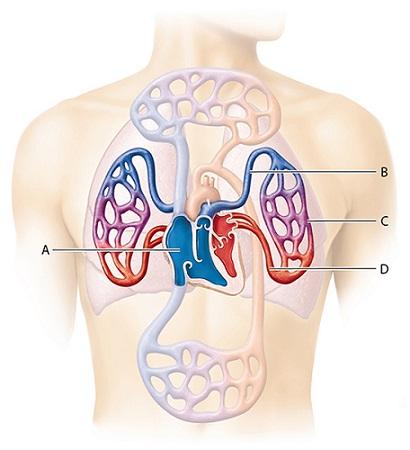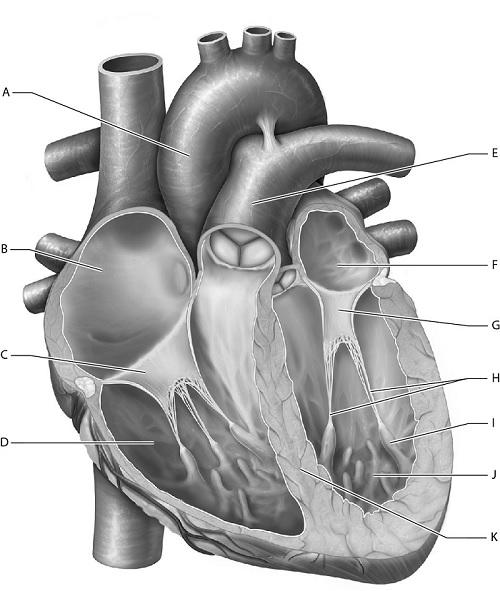
1-The right side of the heart pumps deoxygenated blood into __________.
A
B
C
D
B

2-Identify the right atrium.
E
B
J
G
B

3-Identify the left ventricle.
E
J
B
A
J

4- Identify the papillary muscle.
K
J
I
B
I

5-Identify the pulmonary trunk.
J
B
G
E
E

6-Identify the interventricular septum.
K
G
E
I
K

7-Identify the mitral (bicuspid) valve.
K
J
G
E
G
8-The apex of the heart is __________.
anterior
inferior
superior
posterior
inferior
9-What surface groove separates the right and left ventricles?
interventricular sulcus
interventricular septum
atrioventricular sulcus
interatrial septum
interventricular sulcus
10-The pulmonary circuit involves blood flow from the heart to the:
lungs.
brain.
body.
liver.
lungs.
11-The vessels that deliver oxygen to the tissues of the body are part of the __________.
pulmonary circuit
conducting circuit
systemic circuit
coronary circuit
systemic circuit
12-Which of the following vessels carries oxygenated blood?
superior vena cava
pulmonary trunk
pulmonary artery
pulmonary vein
pulmonary vein
13-Blood from the systemic circuit returns to the heart via the __________.
pulmonary arteries
venae cavae
cardiac veins
pulmonary veins
venae cavae
14-Which hormone decreases cardiac output by decreasing blood volume and preload?
aldosterone
antidiuretic hormone (ADH)
atrial
natriuretic peptide (ANP)
norepinephrine
atrial natriuretic peptide (ANP)
15-What two values are needed in order to calculate cardiac output (CO) for a ventricle?
end-diastolic volume (EDV) and end-systolic volume (ESV)
heart rate (HR) and end-diastolic volume (EDV)
stroke
volume (SV) and blood pressure (BP)
stroke volume (SV) and
heart rate (HR)
stroke volume (SV) and heart rate (HR)
16-What largely determines preload?
afterload
end-systolic volume (ESV)
stroke volume
end-diastolic volume (EDV)
end-diastolic volume (EDV)
17-Afterload is described as:
the length or degree of stretch of the sarcomeres in the
ventricular cells before they contract.
the ability to generate
tension.
the amount of blood that has drained into the
ventricle by the end of the filling phase.
the force the
ventricles must overcome to eject blood into their respective arteries.
the force the ventricles must overcome to eject blood into their respective arteries.
18-Which of the following happens immediately after the P wave?
The ventricles contract.
The atria contract.
The atria
relax.
The ventricles relax.
The atria contract.
19-The aortic valve closes when __________.
the pressure in the left ventricle falls below atrial pressure
the pressure in the left ventricle raises above the atrial
pressure
the pressure in the left ventricle raises above the
aortic pressure
the pressure in the left ventricle falls below
aortic pressure
the pressure in the left ventricle falls below aortic pressure
20-During what phase does blood flow from the ventricles into the pulmonary trunk and aorta?
ventricular filling
isovolumetric contraction phase
isovolumetric relaxation phase
ventricular ejection phase
ventricular ejection phase

21-Which of the following events will immediately follow the phase of the cardiac cycle depicted in the figure?
the atrioventricular valves open.
the semilunar valves open
ventricular systole
blood is ejected into the pulmonary
artery and aorta
the atrioventricular valves open.
22-The P wave on an electrocardiogram (ECG) represents the depolarization of cells in the:
atria.
ventricles.
atrioventricular (AV) node.
sinoatrial (SA) node.
atria.
23-What valve prevents the backflow of blood from the right ventricle into the right atrium?
tricuspid valve
bicuspid (mitral) valve
pulmonary valve
aortic valve
tricuspid valve
24-What vessel delivers oxygenated blood to systemic capillaries for gas exchange?
coronary artery
aorta
circumflex artery
pulmonary trunk
aorta
25-What vessel(s) deliver oxygenated blood to the left atrium?
aorta
pulmonary arteries
pulmonary trunk
pulmonary veins
pulmonary veins
26-Autorhythmicity in the heart is the responsibility of:
skeletal muscle cells.
cardiac pacemaker cells.
smooth
muscle cells.
contractile cells.
cardiac pacemaker cells.
27-What characteristic differentiates cardiac muscle cells from skeletal muscle cells?
intercalated discs
sarcoplasmic reticulum
striations
excitability
intercalated discs
28-Unlike skeletal muscle action potentials, cardiac muscle action potentials __________.
do not involve repolarization
have a short refractory period
begin with a rapid depolarization phase
involve calcium
voltage-gated channel
involve calcium voltage-gated channel
29-What normally serves as the pacemaker of the entire heart?
Purkinje fiber system
atrioventricular (AV) bundle
sinoatrial (SA) node
atrioventricular (AV) node
sinoatrial (SA) node